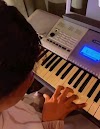#learn sheet music part 6: Understanding the Treble Clef
The image below shows a treble clef, which is an essential symbol in music notation. Understanding the treble clef is crucial for reading and playing music on the piano. Let's dive into what the treble clef signifies and how to read notes in this clef.
#### What is the Treble Clef?
The treble clef, also known as the G clef, is used to notate higher-pitched notes, typically played with the right hand on the piano. The symbol curls around the G line, indicating where the note G is located on the staff.
#### The Staff and Note Placement
The staff consists of five lines and four spaces. Each line and space represents a different musical pitch. Here are the notes for each line and space in the treble clef:
- **Lines (from bottom to top):**
- E (Every)
- G (Good)
- B (Boy)
- D (Does)
- F (Fine)
- **Spaces (from bottom to top):**
- F (F)
- A (A)
- C (C)
- E (E)
A useful mnemonic to remember the lines is "Every Good Boy Does Fine," and for the spaces, "FACE."
#### How to Read and Play Notes in the Treble Clef
1. **Identify the Note**: Look at where the note head is placed on the staff.
2. **Match to the Keyboard**: Find the corresponding note on the piano. For example, if a note is on the bottom line, it is an E, and you should play the E above middle C.
#### Practical Example
Let's take a simple example: reading and playing a scale in the treble clef.
**C Major Scale:**
- The notes are C, D, E, F, G, A, B, and C.
- In the treble clef, these notes appear as follows:
- C (first ledger line below the staff)
- D (space below the first line)
- E (first line)
- F (first space)
- G (second line)
- A (second space)
- B (third line)
- C (third space)
**Playing the C Major Scale:**
1. Start with your thumb (1) on middle C.
2. Use your index finger (2) for D, middle finger (3) for E, ring finger (4) for F, and little finger (5) for G.
3. Cross your thumb under your fingers to play A with your thumb (1) and continue with B (2) and C (3).
#### Exercises
1. **Note Identification**: Write out random notes on a blank staff with a treble clef and practice identifying and playing them on the piano.
2. **Scales**: Practice playing the C major scale and other major scales, both ascending and descending, while saying the note names out loud.
3. **Simple Melodies**: Find simple melodies written in the treble clef and practice playing them. Examples include "Twinkle, Twinkle, Little Star" or "Mary Had a Little Lamb."
#### Conclusion
Understanding the treble clef is fundamental to reading music and playing the piano. By familiarizing yourself with the notes on the staff and their corresponding keys on the piano, you'll be able to read and perform a wide range of music.
Share this tutorial with three friends or groups who are learning piano, and follow Vicpiano for more piano tutorials and tips! Happy playing! 🎶










0 Comments